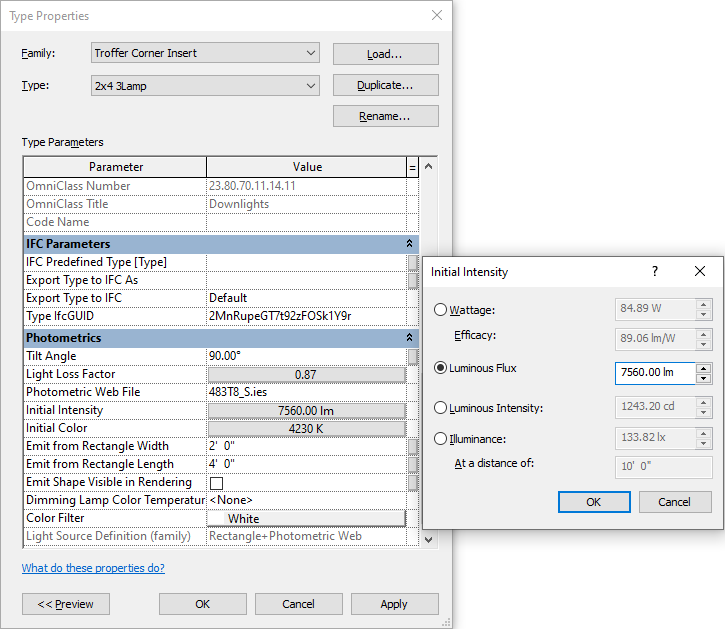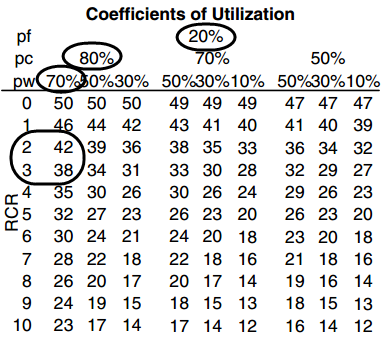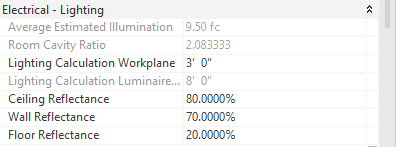Average Estimated Illumination
The Average Estimated Illumination (AEI) for each space is calculated by determining the Lumens contributed by each fixture at the lighting calculation work plane, and dividing by the space's area.

Space Illumination Example
In this example:
- The lighting equipment is a Troffer Corner Insert - 2x4 3Lamp using the 483T8_S.ies Photometric Web File.
- The dimensions for the space are 20' 0" x 30' 0".
- The bottom of the lighting fixture is placed at 9' 6".
- Ceiling reflectance: 80%
- Wall reflectance 70%
- Floor reflectance: 20%
The additional formulas used to calculate the average estimated illumination for the space are as follows:
- Lumens at Work Plane
- Room Cavity Height
- Room Cavity Ratio
Lumens at Work Plane
The Lumens at the work plane contributed by each fixture are computed as follows: WL = II * LLF * CU.
- WL = Lumens at work plane
- II = Initial Intensity
- LLF = Light Loss Factor
- CU = Coefficient of Utilization
The Initial Intensity and Light Loss Factor are both type properties of each lighting fixture type. You access these properties in the fixture’s Type Properties dialog.

For this example, the fixture's Initial Intensity is 7560 lumens, and the Light Loss Factor is 0.87.
The CU is computed based on the Space reflectance properties (ceiling, wall, and floor), as well as the space's Room Cavity Ratio (RCR). If the lighting fixture is not in a space, the CU cannot be determined, and the fixture does not contribute to a space's AEI.

The RCR is calculated based on the Room Cavity Height (RCH) and the Lighting Calculation Workplane, which is a property of each space instance.
Room Cavity Height
The Room Cavity Height is computed as: RCH = LP - LCW.
- RCH = Room Cavity Height
- LP = Lighting Calculation Luminaire Plane (The height of the light sources in the space)
- LCW = Lighting Calculation Workplane
In this example: RCH = 9' 6" - 3' 0" = 6' 6". (If there are multiple light sources at varying heights, the lowest height is used.)
Room Cavity Ratio
Room Cavity Ratio is calculated as: RCR = 2.5 * RCH * P / A.
- RCR = Room Cavity Ratio
- P = Room Perimeter
- A = Room Area
In this example: RCR = 2.5 * 6.5 * 100 / 600 = 2.708.
Coefficients of Utilization
To determine the Coefficient of Utilization manually, you would refer to a luminaire datasheet. A portion of the datasheet for the fixture described by the 483T8_S.ies Photometric Web File is shown here.
The floor (pf), wall (pw), and ceiling (pc) reflectances are all properties of the space instance, and the RCR is computed as described above. Using interpolation, you can compute the CU as approximately 40.8. Revit reports the value of 40.9 The difference can likely be accounted for as rounded values in the printed table.

Note the values for reflectance:

Applying the Lumens at Work Plane formula for this example: WL = 7560 * 0.87 * 0.409 = 2690 lm.
The WL for this fixture represents the total lumens for the space. For this single fixture in the space, the resulting foot candle level is determined using the AEI formula: 2690 lm / 600 sf = 4.48 fc.
If there are multiple fixtures in the space, the RCR is based on the lowest fixture in the space (which is reported in the Lighting Calculation Luminaire Plane parameter), the CU is computed for each fixture instance based on this RCR, and the WL for each fixture are summed, then divided by the space's area.
For example, assuming another fixture is added at an 8' 0" elevation, the RCR becomes 2.08, and the CU for both fixtures becomes 0.433.
WL = 7560 * 0.87 * 0.433 = 2848
Thus, the total AEI = (WL1 + WL2) / Area = (2848 + 2848) / 600 = 9.50 fc.
